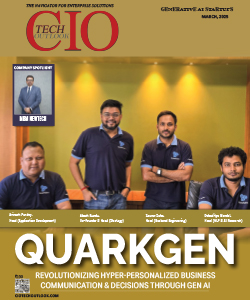Smart Payment Solutions: The Role of AI and IoT in the Evolution of Payments
Manoj Varma, Head - Payments, Lyra Network, India

Manoj Varma is a dynamic Industry professional, production engineer, and techno-functional person with an understanding of technology and business aspects, an entrepreneurial bent of mind, and out-of-the-box thinking, he has been the crusader of various pertinent projects and has many emerging payment solutions associated with his name. With over 16 years of experience in the payments domain, he is responsible for creating digital payment products and solutions for Lyra and launching them in the market.
In a world where technology is constantly advancing, it is no surprise that how we make payments is also evolving. From the days of barter and cash transactions to the advent of credit cards and digital wallets, the payment landscape has seen remarkable changes. However, the latest wave of innovation is making significant strides in the realm of smart payment solutions, and at the heart of this transformation are two cutting-edge technologies: Artificial Intelligence (AI) and the Internet of Things (IoT).
Artificial Intelligence (AI) and the Internet of Things (IoT) are playing a pivotal role in shaping the future of payments. These technologies are not only transforming the way we make transactions but are also enhancing security, convenience, and customer experiences. Traditional payment methods have come a long way, from physical cash to credit cards and digital payments. However, as technology continues to advance, so do our expectations of payments. Consumers demand seamless, secure, and instantaneous transactions, and businesses must adapt to meet these expectations.
Imagine walking into your favorite cafe, and even before you order, the barista knows your usual order and presents it with a friendly smile, or a payment SoundBox, a small portable device that notifies you of successful digital payment with a sound alert. That's the magic of AI and IoT in digital payments – personalization. AI-powered systems analyze vast amounts of data to provide customers with tailored payment options, suggestions, and discounts. The days of one-size-fits-all transactions are behind us, as AI tunes payments to the unique preferences of each user. On the other hand, The Internet of Things (IoT) plays a vital role in enhancing the digital payment experience. Connected devices, from smartwatches to fridges, are not only convenient but also ensure real-time information flow. IoT adds a layer of security by enabling biometric authentication through fingerprint scanning or facial recognition, reducing the reliance on passwords and PINs.
From local to global: Transformative Power of AI and IoT
AI and IoT are democratizing finance by extending access to underserved populations. Mobile banking apps and IoT-connected devices are bringing financial services to remote areas with limited access to traditional banking. AI-powered credit scoring models are assessing creditworthiness, even for individuals with no credit history, making loans and financial services accessible to all.
Cross-border transactions have historically been complex, time-consuming, and expensive. AI and IoT are changing that narrative. AI-driven translation and language processing tools bridge linguistic divides, while IoT ensures the authenticity and location of goods in transit. These technologies are making cross-border transactions faster, cost-effective, and transparent, benefiting both global businesses and international travelers. Together, these technologies are not only revolutionizing the way we make payments but also reshaping the entire financial ecosystem.
The Integration of AI in Payments: The Brainpower Behind Smarter Payments
Artificial Intelligence has been a game-changer in the fintech industry. Its application in payments is multifaceted, revolutionizing every aspect of the transaction process:
Fraud Detection: AI-powered algorithms can analyze massive datasets in real-time, identifying patterns and anomalies that may signal fraudulent activities. This enhances security and reduces false positives, minimizing inconvenience to genuine customers.
Personalized Experiences: AI-driven recommendation engines can offer customers tailored product and service suggestions, increasing engagement and boosting sales. This personalization extends to payment options, making transactions more convenient.
Chatbots and Virtual Assistants: AI-driven chatbots and virtual assistants can provide instant customer support, helping users with payment-related queries, troubleshooting issues, and providing 24/7 assistance.
Credit Scoring: AI algorithms can assess creditworthiness more accurately by analyzing a broader range of data points, enabling greater financial inclusion and fairer lending practices.
Risk Management: AI models can assess transaction risk in real-time, allowing businesses to make informed decisions about whether to approve or deny payments.
The Power of IoT in Payments: Connecting Payments to the Physical World
The Internet of Things, with its network of interconnected devices, is another transformative force in the fintech space, extending its influence to payments:
Seamless, Contactless Payments: IoT enables the integration of payment capabilities into a wide range of connected devices, such as smartwatches, cars, and home appliances. This allows for frictionless, contactless payments, making transactions more convenient than ever before.
Supply Chain Optimization: IoT sensors can provide real-time data on the movement of goods in the supply chain, automating payments based on predefined conditions or milestones. This can enhance transparency and reduce disputes.
Inventory Management: IoT-powered inventory management systems can automatically reorder products when stock is low, streamlining the procurement process and facilitating prompt payments to suppliers.
Energy-Efficient Payments: IoT can be used to optimize energy consumption in payment processing centers, reducing operational costs and making payments more environmentally friendly.
AI and IoT are orchestrating a profound transformation in digital payments. They are revolutionizing user experiences, fortifying security, enabling predictive insights, simplifying cross-border transactions, and promoting financial inclusion. As these technologies continue to evolve, Fintech companies, regulators, and consumers must collaborate to create a secure, efficient, and inclusive payment ecosystem that harnesses the potential of these transformative technologies while safeguarding against risks and ensuring privacy and fairness for all users.
Driven by the synergistic power of Artificial Intelligence and the Internet of Things, the future of payments is undeniably smart. Fintechs and other financial institutes should be committed to harnessing these technologies to provide customers with secure, convenient, and personalized payment solutions. By staying at the forefront of these innovations, we can create a financial ecosystem that not only meets but also exceeds the evolving expectations of consumers and businesses alike. It is an exciting time to be a part of the fintech industry, and we all should look forward to witnessing this transformative journey ahead.




